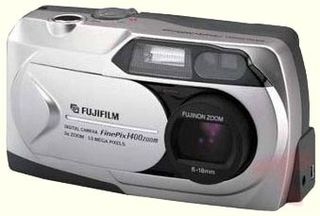Four 5-Megapixel Cameras In Review
Three Categories
The digital market is in full expansion and can be divided into three categories.
Under $400 This is what used to be thought of as downmarket and has now become the digital starter price. In this range, you could say there is a before and after the Fuji FinePix 1400 Zoom, undoubtedly the first really good low-priced digital camera. As the digital market has been evolving very rapidly, this camera has been technologically outpaced and, so, discontinued. The new cameras in this category can be qualified by their 1.3 or 2.1 megapixel sensors, 3x optical zoom, USB connections and 8 MB memory cards. Note also the recent appearance of a cheaper sub-category, without the optical zoom.

$400 - $800 At this level, we get an increase in resolution, with sensors ranging from 2 to 4 megapixels. These cameras are designed for digital photography enthusiasts, including amateur photographers, business professionals (real-estate agents, site locators, Webmasters, etc.) and those who previously had a less sophisticated model and want to upgrade to newer technology. These cameras usually have a wide range of manual functions, starting with white balance, burst mode, several kinds of exposure metering, etc. A movie mode is also coming into vogue, and, increasingly, programs shared with the silver halide sector: P, S, A and M (which we shall discuss later).
Over $800 Though it is possible to spend more, here we enter the elite category, because we are not just talking about nearly professional-level prices, but also the technological forefront. There are not many models in this category. Marketing these treasures is not the only goal - they also (perhaps primarily) serve as a technological showcase for the manufacturers to display their know-how and development potential for their future models, a pattern which has been illustrated by past experience. Currently, these cameras are at the top of the pack, but gradually, these and similar models will drop to mid-range and eventually join the starter price category. As such, everything counts at this price level, so these top-of-the-line digital cameras usually offer all the best features. Here's a brief summary of the must-have standard features: 5 megapixel CCD sensor; capture modes (P, S, A, M); white balance and manual focus; powerful zoom lens with high brightness (usually f/2 in wide angle); sharpness and exposure adjustment; and etc. They can be used in manual or automatic mode, and the most powerful of them are even equipped with reflex viewfinders and control rings for zoom and focus.
The four cameras we tested currently meet the criteria listed above:
- Minolta Dimage 7
- Nikon Coolpix 5000
- Olympus E-20
- Sony DSC-F707
These four offer what is the best available, but each is based on a different concept. One is compact; another is twin-bodied. The other two are designed to be similar to SLR cameras. Their features are worthy of a very good conventional camera: f/2 aperture; 28 mm wide angle; burst mode; up to ISO 800 sensitivity; zoom ring; 1/2000 to several dozen seconds shutter speed; etc.
Without further ado, let's move on to the details.
Stay On the Cutting Edge: Get the Tom's Hardware Newsletter
Join the experts who read Tom's Hardware for the inside track on enthusiast PC tech news — and have for over 25 years. We'll send breaking news and in-depth reviews of CPUs, GPUs, AI, maker hardware and more straight to your inbox.
Current page: Three Categories
Prev Page Making The Switch From Analog To Digital Next Page Formats And CompatibilityMost Popular



